On a mild December evening in 2015, a red pickup truck inched past an Islamic center in Philadelphia, just as the city was giving way to darkness. On its second pass, around 11 p.m., the passenger in the vehicle leaned out the window and tossed an object across the sidewalk.
The severed pig’s head rolled to the front door of the Al-Aqsa Islamic Society, one of the largest mosques in Philadelphia. Pork is forbidden in Islam, and the pig’s head was another sign of growing Islamophobia in the United States.
Days earlier, a couple claiming allegiance to the so-called Islamic State stormed the Inland Regional Center in San
Bernardino, California, shooting 14 people to death and injuring an additional 22 people. Donald Trump, then a Republican candidate for president, called for a complete and indefinite ban on Muslims entering the United States. Across the country hate crimes against Muslims were nearing a rate comparable to that after 9/11.
The perpetrators of the Philadelphia hate crime won that evening in 2015—they drove away from the crime. An investigation by police, the FBI, and the city’s Human Relations Commission has not caught the perpetrators. Yet members of the mosque and people of all faiths in the surrounding city have won every day since.
Within a week, hundreds of neighbors streamed into the Islamic Society’s parking lot for a barbecue. Islamic, Jewish, and Christian clergy led the group in prayer. Children played and community members interacted with one another, some for the first time, before sharing a meal.
The mosque’s response to the hate crime was not just a one-day event. The barbecue got attention, but they wanted to do something to inspire passersby. They wanted their message of peace to be seen from afar, so they turned their attention to the high-reaching mosque walls facing the parking lot. The leaders decided it was time to revisit a form of expression and peacebuilding that had united the community more than a decade earlier: mural art.
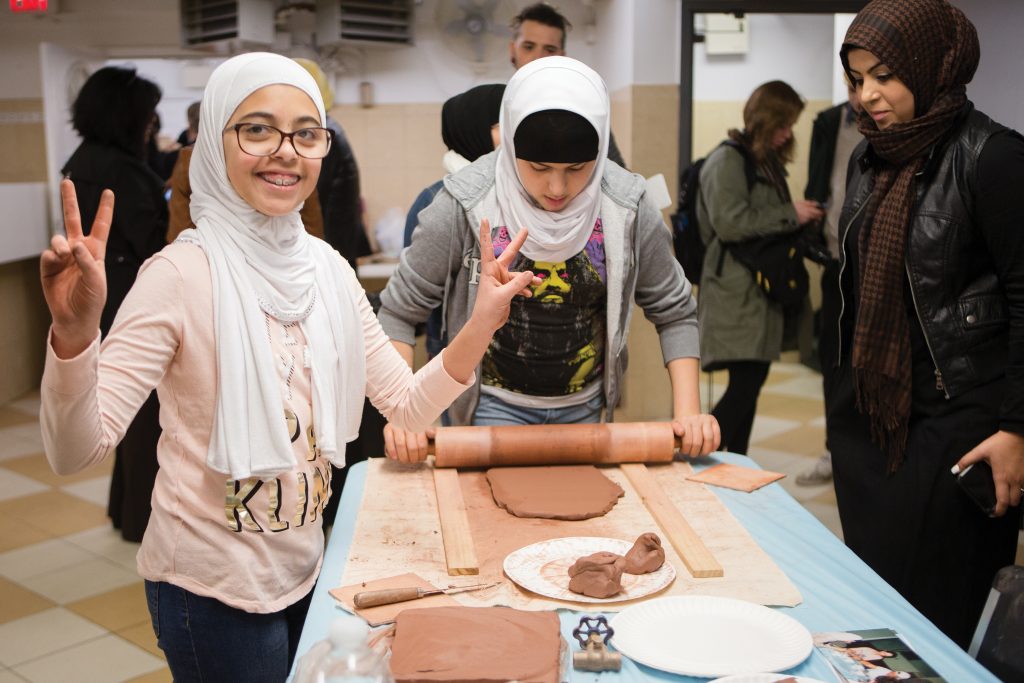
In the early 2000s, in the months following 9/11, the approximately 500 Philadelphia families who are members of the Al-Aqsa congregation feared people would throw bricks at the building.
Adab Ibrahim, the community outreach coordinator for the society, was afraid to take her children to school. People wearing hijabs, like her, were having them ripped off in public. She says that much of the fear from non-Muslim Americans was driven by ignorance. People did not know the core tenets of Islam.
The lifelong Philadelphian has degrees in psychology and sociology from Temple University, but she has always had a passion for artmaking. She began exploring the medium as a way to create dialogue between community members. Exposure to others in a safe setting could be a way to quell the uncertainty of the time. She decided that art could be a starting point for this dialogue.
“Dialogue comes after the artwork,” Ibrahim says. “It’s healing. It’s a creative force, especially when it takes place in
a community.”
Ibrahim created a partnership between the mosque and Artwell, a local youth arts education program focused on underserved communities. The two organizations submitted an application to Mural Arts Philadelphia, the largest public arts organization in the country.
The mission was to transform the exterior of the mosque in the Olde Kensington neighborhood. From the outside, the average person could hardly tell it was a mosque. The old building had been a furniture warehouse before the society was founded in 1989. The lot now includes a grocery store as well as an elementary and high school.
“We didn’t know what to do with it,” Ibrahim says. “It was a drab old warehouse.”
The organization wanted to make a statement, says Marwan Kreidie, executive director of the center. An estimated 200,000 Muslims live in Philadelphia, and a public art project led by professionals but including community members of all ages could raise awareness about the mosque as well as dispel myths about Islam.
“We needed to show people the positive part,” Kreidie says. “It was something that the whole community could work on. We thought it was important to do a lot of projects together.”
It was the emphasis on bringing people together that caught the eye of Jane Golden, founder and executive director of Mural Arts. Her organization produces between 50 and 100 public art projects a year. The project at the mosque was special because it dealt with a direct social issue and had the potential to have a lasting impact, she says.
“When we reviewed the applications, we were like, ‘How in the world could we ever turn them down? This is so important,’ ” Golden says. “A project like this is really about bringing constituents together to speak with a unified voice. And, at the same time, overcoming the stigma and the atmosphere of hostility that sometimes surrounds the Muslim faith.”
Choosing the right group of artists was crucial because they had to balance various factors such as the makeup of the building, the intended message, the look of the surrounding community, and the opinions of mosque members. Context is everything, Golden says.
“Even if it’s not obvious at first glance, you want it to be obvious at third or fourth glance. It should seep in somewhere in your psyche that the artist was considering the neighborhood,” she says.
The project chose three artists: Joe Brenman, a sculptor and mosaic artist; Cathleen Hughes, an abstract painter; and Fadwa Kashkash, a specialist in calligraphy. Mural Arts was able to fund the project, and together they transformed the drab warehouse into a prized part of the neighborhood.
“People tend to have images of others, and things like art-making level the playing field,” Golden says. “It invites people into a civic arena where there is room for connection. . . . When people are creating together, something profound happens because you’re having conversations, you’re working on something that goes far beyond yourself. It connects you to the larger world.”
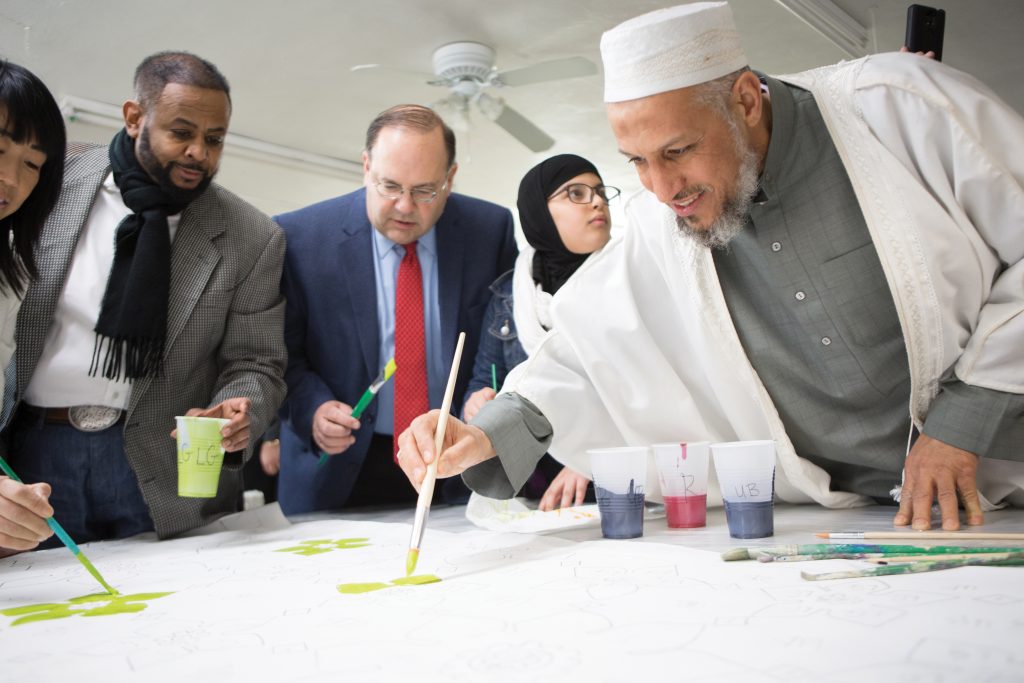
Brenman lives several blocks from Al-Aqsa, but in the early 2000s he had no idea it was a mosque. The 67-year-old artist agrees with others who say the building looked shabby and beat-up.
He began making ceramic clay tiles for the mosque in fall 2003. The entire community was invited to help through newspaper advertisements and word-of-mouth. Fourth graders from the area made the majority of the tiles. Students from Al-Aqsa’s school, La Salle Academy (a Catholic school), and John Moffet Elementary School (a public school) visited each other’s classrooms and designed tiles together that incorporated their ideas of peace. The interactions taught the children about different religions and cultures, Brenman says.
Abby Stamelman Hocky, executive director of the Interfaith Center of Greater Philadelphia, led some of the classroom discussions. Creating art can be a spiritual process, she says. Using one to talk about the other fights ignorance and helps people feel fully understood.
“You deserve to live out your life in a full and unreserved way,” Hocky says. “What we hear all the time from people is that religion is the last barrier [of conversation].”
The work of the area’s young people built trust among adults in the community. Soon the entire neighborhood
got involved in the process. The artists held open work days. Volunteers helped Hughes paint the canvas that would later be plastered onto the building.
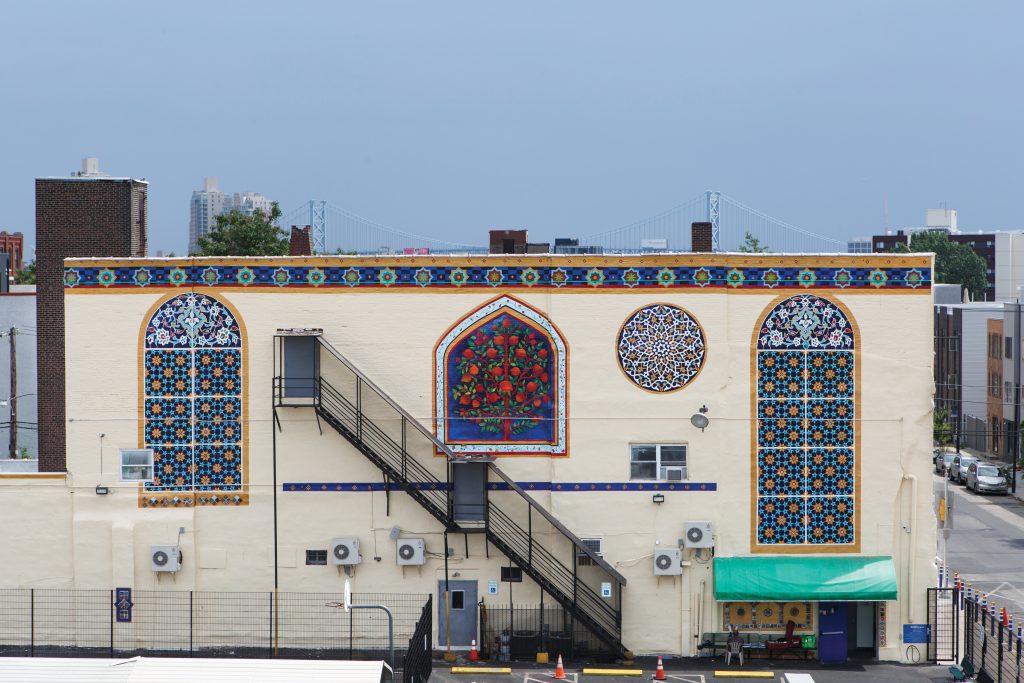
“That was really amazing, actually, to see the outpouring of the energy of the people who wanted to join in and be part of it,” Brenman says. “People from all over the city—different churches and different synagogues—and people who weren’t really connected to any religion at all. . . . Doing the art was a comfortable way for people to do that and show their support.”
Brenman is Jewish. During the installation of the first mural, he mounted tiles on the wall with several men who were Palestinian. Brenman says they had never interacted with a Jewish person before. He had never worked with Palestinians, either. The experience changed the way the men saw Brenman, and Brenman, in turn, opened his mind about the Muslim faith. Being present for daily prayers at the mosque was a moving experience, he says.
“My inspiration [for the mural] was to reach out and make a connection with this community, to try to turn around some of the bad feelings that were happening,”
Brenman says. “I really wanted to help make a bridge to the Muslim community from my community, the Jewish community, and also for the city.”
The fruits of the artists’ work were seen in November 2004, when the community gathered to dedicate the Doorways to Peace mural.
The two street-facing walls feature sweeping amber and gold arches over windows patterned with navy blue stars over turquoise. White flowers on a navy banner line the top of the building, creating depth with the open Philadelphia sky behind the building. In a line wrapping around the building, just above the doorways, Arabic calligraphy on white tiles details the 99 names of God in Islam.
Below each tile is the English translation: the Exalter, the All-seeing, the Beneficent. Finally, written in lettering around a foot tall, the wall reads “Al-Aqsa Islamic Society” and “Al-Aqsa Islamic Academy,” a pronouncement that the mosque is visible and permanent.
“It was a complete transformation,” Ibrahim says. “Not only physical, but coming together as a community, too.”
Working on the mural spurred the center to do more in the community, Kreidie says. The center continues to hold antidiscrimination workshops and English as a Second Language (ESL) courses. The building has also served as a voting site.
The entire south-facing wall on Jefferson Street is dedicated to the community. Clay tiles in rainbows of emerald, orange, blue, yellow, and white create three arching doorways decorated with geometric patterns and various expressions for hope, peace, and love. The doorways are Ibrahim’s favorite part of the building, she says.
Hundreds of people from various faiths showed up for the dedication. The events of 9/11 were still present in people’s minds, which made the message of hope expressed by the crowd and the art even more powerful, Golden, the Mural Arts Director, says.
“It was just so moving because it was a statement of unity,” she says. “People felt they were a part of something larger than themselves. And, to recognize and look at each other and not feel divided but, in a sense, feel this deeper connection.”
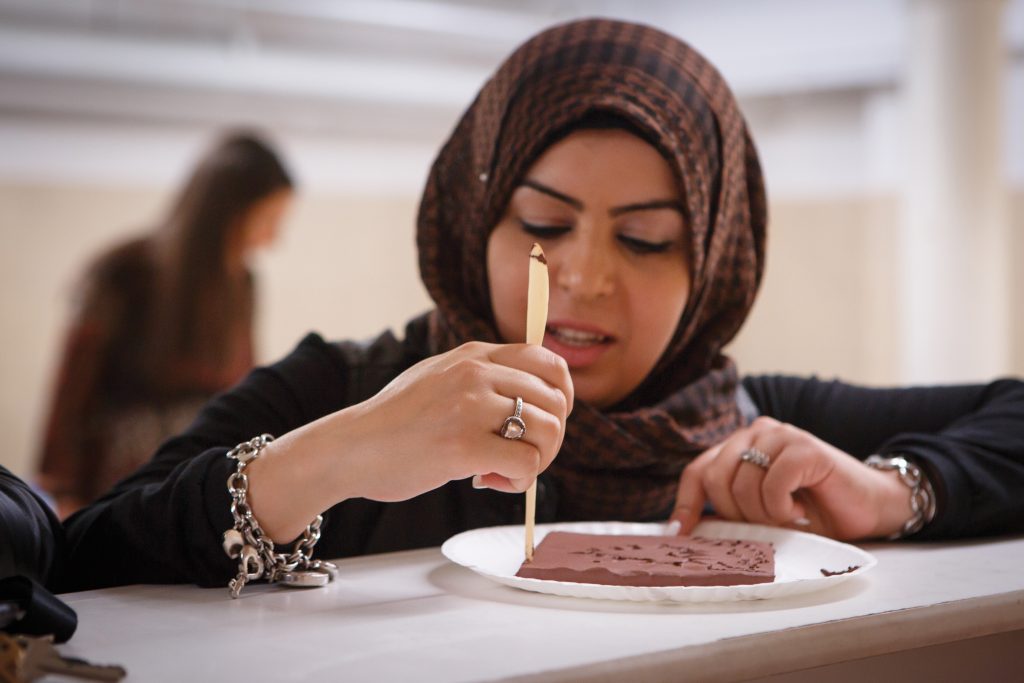
More than 10 years later, in 2015, the members of Al-Aqsa were again forced to reconcile with a growing and vocal anti-Islamic sentiment across the nation. The pig’s head was a kind of wake-up call.
“It was devastating,” Kreidie, the center’s executive director, says. “We didn’t expect anything like that in that neighborhood. And I’m convinced, as I was then, that it was not someone from the neighborhood who did that.”
But Kreidie was more surprised by how the neighborhood responded. Neighbors approached the mosque to plan an event to show that the hate crime would not be tolerated. Community members, imams, priests, and rabbis orchestrated the eventual block party, Kreidie says.
“You had one guy or two guys in a pickup truck throw a pig’s head. You had 500 people show up to support their neighbors. That, to me, was a positive sign,” he says.
The center was already in talks for a second mural before the pig’s head incident, but the act sped up efforts, Golden says. The second group of artists again included Brenman, as well as Parris Stancell.
The sense of urgency for another public statement of unity was heightened even more when a man claiming allegiance to the so-called Islamic State attempted to murder a city police officer in January 2016. This time around, Ibrahim says, the mosque’s board was more willing to take on the project.
“This time around, knowing how much joy this brought to the community, it wasn’t as hard,” she says.
The first public artmaking day was packed with more than 100 volunteers. Philadelphia mayor Jim Kenney and city council members were there, too.
“The mosque and all of us, we were united in saying, ‘We are not going to accept this kind of behavior. It’s unacceptable. It’s un-American. It’s not right,’ ” Golden says. “It was just a strong showing against that kind of discrimination.”
Stancell designed the murals, which are known as Windows to Peace. He was a staff artist with Mural Arts at the time and led members in a paint-by-number system to create the Windows to Peace mural, featuring sweeping windows that stretch across the mosque’s north wall.
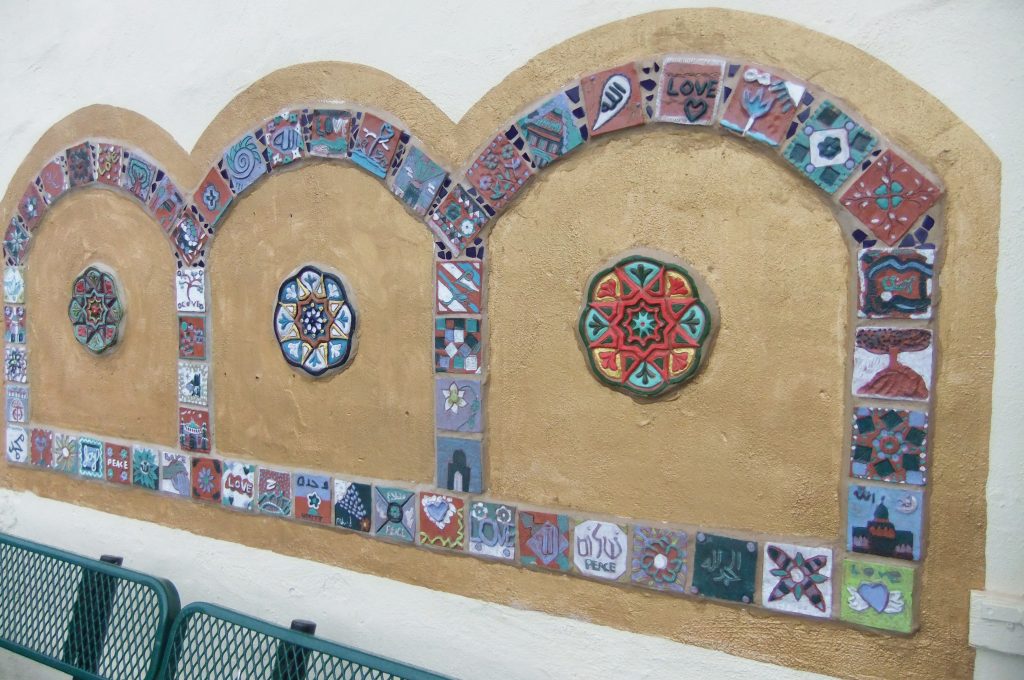
Two cathedral-style windows, well over 20 feet tall, are detailed in yellow and turquoise flowers. The window’s top is a bouquet of white and red flowers. A symmetric circle, webbed with lines of gold and white on navy, sits nearby, below the blue and black banner lining the top of the wall.
The project was at first challenging for Stancell, who calls himself a humanist artist. He usually creates figures but he learned to appreciate the styles and colors of traditional Islamic art. He went to community meetings and had numerous conversations to understand what mosque members were interested in. For example, Ibrahim explained that traditional Islamic colors are turquoise, gold, and dark blue.
Combining this information with his own research, Stancell began designing pieces that caught attention. He became drawn to the abstract quality of the work, he says.
“[Islamic art] has a totally different reason and purpose than Western art,” he says. “Much more spiritual in nature. Much more silent and beautiful. For me, Western art always told the history of mankind. Islamic art speaks to the spiritual complications of mankind.”
In the middle of the Windows to Peace mural is the work’s centerpiece—a red and emerald pomegranate tree. The round fruit pops away from the skinny branches and tender oval leaves. In Islam the pomegranate tree is a symbol of abundance. Its fruit is sacred.
Brenman worked with the same three schools for the second mural. Many of the students he worked with already knew about the project, Brenman says.
“Some of the students’ brothers and sisters had worked on the original one,” he says. “That was really cool.”
The second mural’s dedication in May 2016 was a kind of reunion for people involved in both projects.
Brenman is quick to note that the murals would not have been possible without the tireless work of Ibrahim. She was the liaison between the artists and members of the mosque. She convinced skeptical members of the power of art. She guided the artists on how to convey Islamic themes and colors.
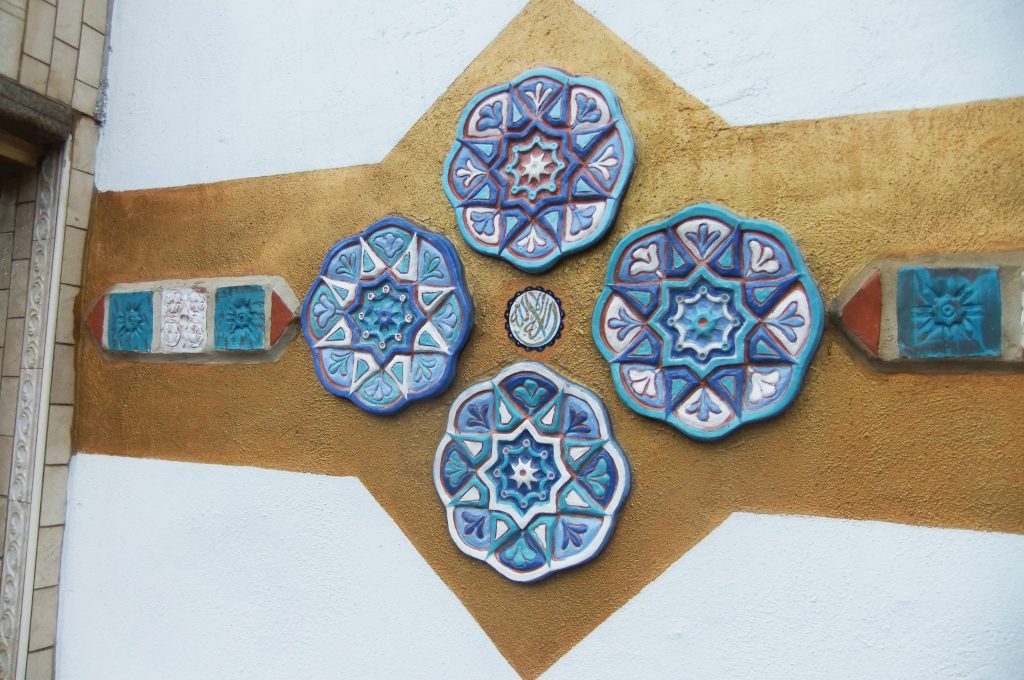
“She was probably the most important person with getting this whole thing going,” Brenman says. “It wouldn’t have happened without her.”
Ibrahim’s commitment to interfaith work was crucial, Brenman says. She organized paint days and tile workshops for the community, bringing together people from the mosque, the surrounding neighborhood, and the city.
The pieces are a source of pride for Al-Aqsa, a sign of their role in and commitment to the community. The project’s driving force, Ibrahim, looks at them and smiles.
“This is one of the prime examples of public Islamic architecture in the city,” she says.
Head image: Doorways to Peace © 2004 Cathleen Hugues & Joe Brenman/City of Philadelphia Mural Arts Program. Photo by Steve Weinik
This article also appears in the April 2017 issue of U.S. Catholic (Vol. 82, No. 4, pages 12-18). Click here to subscribe to the magazine.


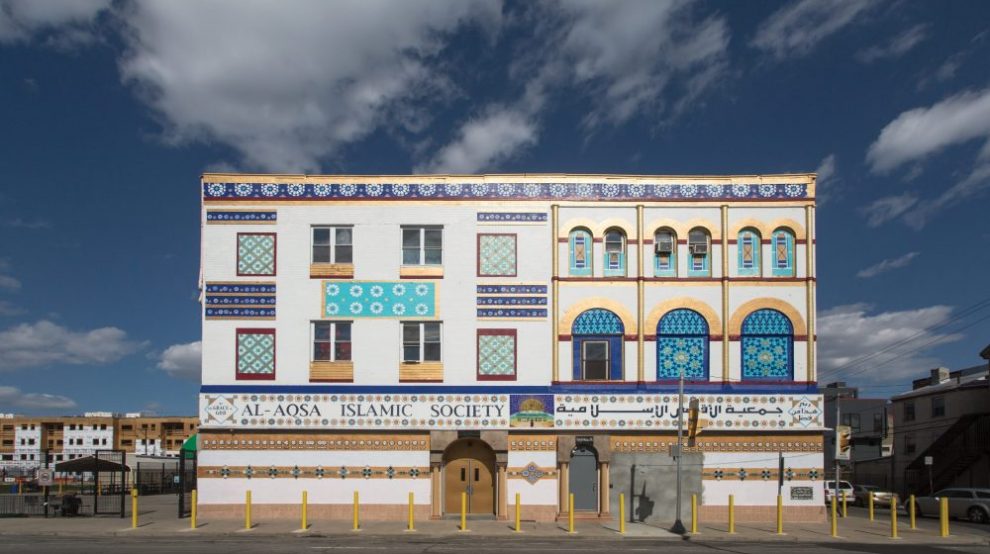

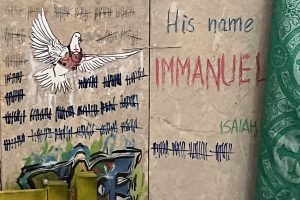
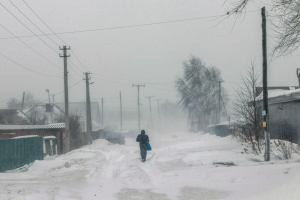
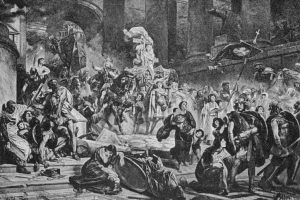





Add comment